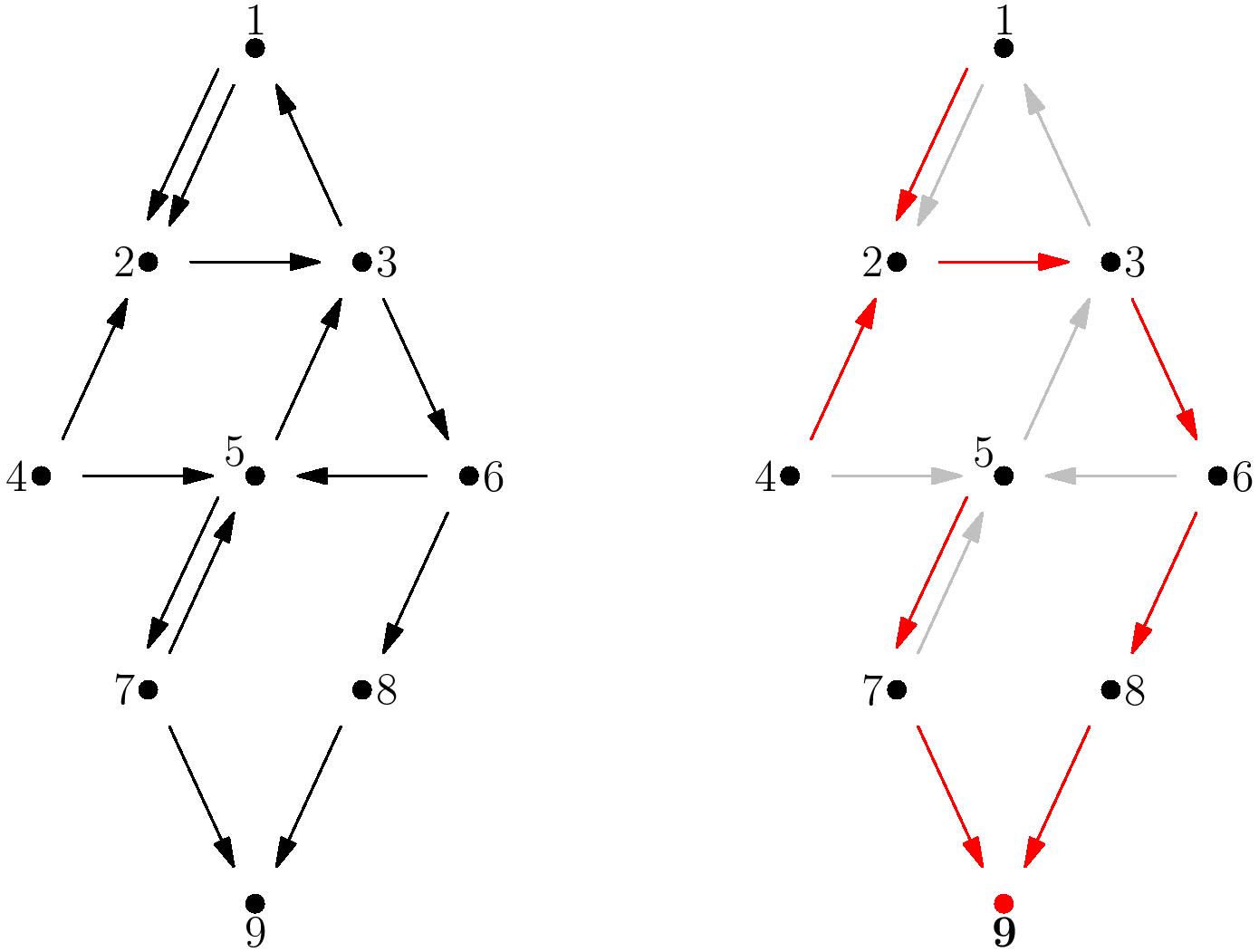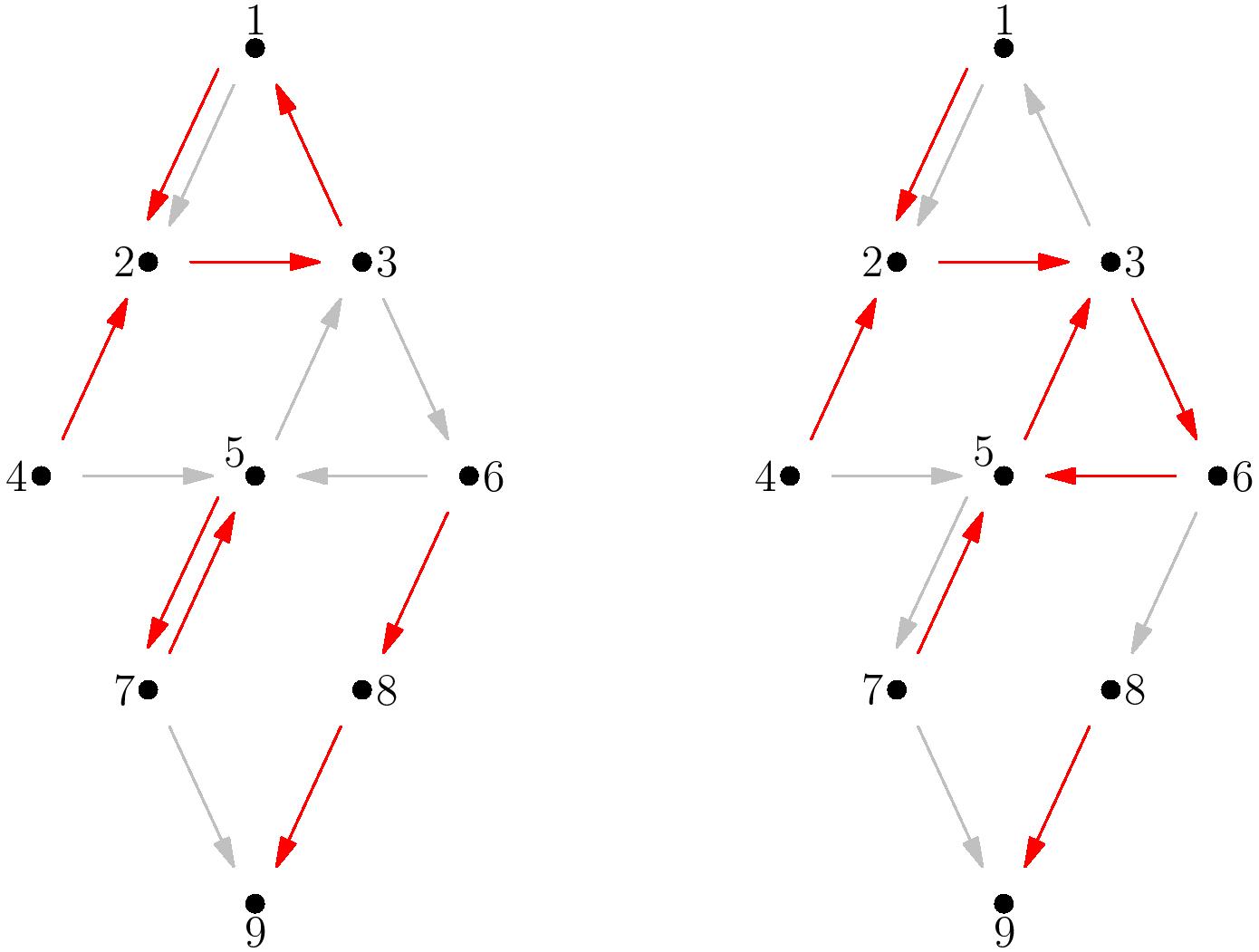
A linear algebra-free proof of the Matrix-Tree Theorem
As a new assistant professor at Colorado State University, I had the privilege this fall of teaching Math 501, the introductory graduate level course in combinatorics. We encountered many ‘mathematical gemstones’ in the course, and one of my favorites is the Matrix-Tree theorem, which gives a determinental formula for the number of spanning trees in a graph. In particular, there is a version for directed graphs that can be stated as follows.
Consider a directed graph $D=(V,E)$, consisting of a finite vertex set $V=\{v_1,\ldots,v_n\}$ and a set of directed edges $E\subseteq V\times V$. An oriented spanning tree of $D$ is a subset $T\subset E$ of the edges, along with a chosen root vertex $v_k$, such that there is a unique path in $T$ from any vertex $v_j\in V$ to the root $v_k$. Such a tree is said to be oriented towards $v_k$, since all the edges are `pointing towards’ the root. The term spanning indicates that $T$ is incident to every vertex in $V$. For example, in the digraph $D$ at left below, an oriented spanning tree rooted at $v_9$ is shown using red edges in the graph at right.
Define $\tau(D,v_k)$ to be the number of oriented spanning trees of $D$ rooted at $v_k$. One can check that, in the above graph, we have $\tau(D,v_9)=16$. Now, let $m_{i,j}$ be the number of directed edges from $v_i$ to $v_j$ in $D$, so that $m_{i,j}$ is equal to $1$ if $(v_i,v_j)$ is an edge and $0$ otherwise. Define the Laplacian of the digraph $D$ to be the matrix \[L(D)=\left(\begin{array}{ccccc} \mathrm{out}(v_1) & -m_{1,2} & -m_{1,3} & \cdots & -m_{1,n} \\ -m_{2,1} & \mathrm{out}(v_2) & -m_{2,3} & \cdots & -m_{2,n} \\ -m_{3,1} & -m_{3,2} & \mathrm{out}(v_3) & \cdots & -m_{3,n} \\ \vdots & \vdots & \vdots & \ddots & \vdots \\ -m_{n,1} & m_{n,2} & -m_{n,3} & \cdots & \mathrm{out}(v_n) \end{array}\right)\] where $\mathrm{out}(v_i)$ is the outdegree of $v_i$, the number of non-loop edges having starting vertex $v_i$ (that is, the number of edges from $v_i$ to a vertex other than $v_i$). Then the (directed) Matrix-Tree theorem states that \[\tau(D,v_k)=\det(L_0(D,k))\] where $L_0(D,k)$ is the deleted Laplacian obtained by deleting the $k$th row and column from $L(D)$. For instance, in the above graph, we have \[\det L_0(D,9)=\det \left(\begin{array}{cccccccc} 2 & -2 & 0 & 0 & 0 & 0 & 0 & 0 \\ 0 & -1 & -1 & 0 & 0 & 0 & 0 & 0 \\ -1 & 0 & 2 & 0 & 0 & -1 & 0 & 0 \\ 0 & -1 & 0 & 2 & -1 & 0 & 0 & 0 \\ 0 & 0 & -1 & 0 & 2 & 0 & -1 & 0 \\ 0 & 0 & 0 & 0 & -1 & 2 & 0 & -1 \\ 0 & 0 & 0 & 0 & -1 & 0 & 2 & 0 \\ 0 & 0 & 0 & 0 & 0 & 0 & 0 & 1 \end{array}\right)=16\] There are several known proofs of the Matrix-Tree theorem. One of the more `standard’ proofs is by induction on the number of edges in the digraph, combined with a bit of linear algebra and row reduction. But it got me thinking:
Is there be a way to prove that the determinant formula holds directly, without relying on induction or linear algebra?
In particular, the determinant of a matrix $A=(a_{ij})$ can be defined explicitly as \[\det(A)=\sum_{\pi\in S_n} \mathrm{sgn}(\pi)\prod_{i} a_{i\pi(i)}\] where $\pi:\{1,2,\ldots,n\}\to \{1,2,\ldots,n\}$ ranges over all permutations (bijections) in the symmetric group $S_n$. For instance, \begin{align*} \det\left(\begin{array}{ccc} a_{11} & a_{12} & a_{13} \\ a_{21} & a_{22} & a_{23} \\ a_{31} & a_{32} & a_{33} \end{array}\right)&=a_{11}a_{22}a_{33}-a_{12}a_{21}a_{33}-a_{11}a_{23}a_{32} \\ &\phantom{=}+a_{12}a_{23}a_{31}+a_{13}a_{21}a_{32}-a_{13}a_{22}a_{31}. \end{align*} It is natural to ask whether applying this formula to the deleted Laplacian gives any combinatorial insight into why the Matrix-Tree theorem should hold. And indeed, there is a direct proof using this combinatorial definition of the determinant!
A combinatorial proof
For simplicity we set $k=n$, so that we are deleting the $n$th row and column to create the deleted Laplacian $\det(L_0(D,n))$. It is sufficient to consider this case since we can always relabel the vertices to have the deleted vertex be the $n$th.
We now give a combinatorial interpretation of each of the terms of the determinant $\det(L_0(D,n)$ as a sum over permutations of $\{1,2,\ldots,n-1\}$. The term corresponding to the identity permutation is the product of the diagonal entries of $L_0(D,n)$, which is \[\prod_{i\neq n} \mathrm{out}(v_i).\] This counts the number of ways of choosing a non-loop edge starting at each vertex $v_i\neq v_n$; we call such a choice an out-edge subgraph $G$ of $D$. Note that all oriented spanning trees with root $v_n$ are out-edge subgraphs, but in general an out-edge subgraph may have cycles among the vertices other than $v_n$. In fact, it is not hard to see that every out-edge subgraph consists a number of nontrivial directed cycles among non-$v_n$ vertices, along with a unique directed path from every other vertex into either one of the cycles or into $v_n$. Two examples of out-edge subgraphs which are not trees are shown below.
Now, for a general term corresponding to a permutation $\pi$ of $\{1,2,\ldots,n-1\}$, consider the decomposition of $\pi$ into disjoint cycles. Suppose there are $p$ fixed points and $r$ nontrivial cycles; let $a_1,\ldots,a_p$ be the fixed points of $\pi$ and $(a_{1}^{(j)}\cdots a_{c_j}^{(j)})$ are the other cycles of lengths $c_1,\ldots,c_r$. Then the sign of $\pi$ is \[\mathrm{sgn}(\pi)=(-1)^{(c_1-1)+\cdots+(c_r-1)}=(-1)^{(n-1-p)-r}.\] The entries multiplied together in the term corresponding to $\pi$ are the outdegrees of $v_{a_1},\ldots, v_{a_p}$ along with the values $-m_{a_{t}^{(i)},a_{t+1}^{(i)}}$. Their product is $(-1)^{n-1-p}$ times the number of ways to choose an edge from $v_{a_t^{(i)}}$ to $v_{a_{t+1}^{(i)}}$ for each $i$ and $t$. Putting this all together, the entire term of the determinant corresponding to $\pi$ is $(-1)^{r}$ times the number of subgraphs formed by choosing a cyclic path on the vertices corresponding to each nontrivial cycle in $\pi$, as well as an out edge for each fixed point. Such a choice is an out-edge subgraph that is compatible with $\pi$ in the sense that any cycle of $\pi$ corresponds to a cycle on the subgraph.
For some examples of compatibility, the permutations $(123)$, $(123)(57)$, $(57)$, and the identity are compatible with the out-edge subgraph drawn above at left. The permutations $(365)$ and the identity are compatible with the subgraph above at right.
It follows that we can rewrite the determinant as: \[\det L_0(D,n)=\sum_{(G,\pi)} (-1)^{r(\pi)}\] where $r(\pi)$ is the number of nontrivial cycles of the $\pi$, and where the sum ranges over all pairs $(G,\pi)$ where $G$ is an out-edge subgraph and $\pi$ is a permutation compatible with $G$. (Note that the same out-edge subgraph $G$ may occur several times, paired with different permutations $\pi$.)
We finally construct a sign-reversing involution on the compatible pairs $(G,\pi)$ that cancel all the negative entries in the sum above. In particular, if $G$ has no cycles then send $(G,\pi)$ to itself, and otherwise consider the cycle $C$ in $G$ containing the vertex with the smallest label among all cycles in $G$. Define $\pi’$ by removing $C$ from $\pi$ if $\pi$ contains the cycle $C$, and otherwise adding $C$ to $\pi$ (in other words, toggle whether the elements of $C$ form a cycle or are all fixed points in the permutation). Then $\pi’$ is still compatible with $G$, so we can map $(G,\pi)$ to $(G,\pi’)$ in this case. This forms a sign-reversing involution in which the only non-canceling terms come from the pairs \[(T,\mathrm{id})\] where $T$ is an out-edge subgraph with no cycles and $\mathrm{id}$ is the identity permutation.
Since a non-cyclic out-edge subgraph on $v_1,\ldots,v_{n-1}$ must be rooted at $v_n$ (for otherwise it would have a cycle), we can conclude that $\det L_0(D,n)$ is the number of spanning trees of $D$ rooted at $v_n$.

